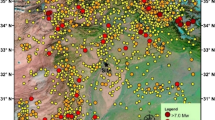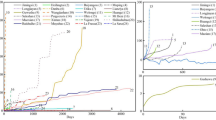Abstract
Landslide distributions in two major areas of northern Japan, Tohoku and Hokkaido, are analysed for multifractal properties. For the latter data set, also the multifractal spectrum for the spatial landslide size distribution is determined and compared to the probability distribution. It is concluded that the fields possess definite multifractal character. This finding is supported by the known multifractality of the main triggering processes, rain and earthquakes. Further support comes from a configuration entropy analysis which is found to be a useful complimentary tool to multifractal analysis. Models leading to multifractality are briefly reviewed. Careful attention is paid to the algorithms used and to the verification of the numerical results. Some general suggestions concerning numerical methods are made.
Similar content being viewed by others
References
Bak P, Tang C, Wiesenfeld K (1988) Self-organized criticality. Phys Rev A 38:364–374
Barnsley MF (1988) Fractals Everywhere. Academic Press, San Diego
Beghdadi A, Andraud C, Lafait J, Peiro J, Perreau M (1994) Entropic and multifractal analysis of disordered morphologies. In: Vicsek, M, and Matsushita M (eds) Fractals in Natural Science. World Scientific, Singapore, pp 360–368
Borgani S, Murante G, Provenzale A, Valdarnini R (1993) Multifractal Analysis of the galaxy distribution: Reliability of results from finite data sets. Phys Rev E 47:3879–3888
Carlson JM, Grannan ER, Swindle GH (1993) Self-organizing systems at finite driving rates. Phys Rev E 47:93–105
Crozier MJ (1986) Landslides: causes, consequences and environment. Croom Helm, London
De Wijs HJ (1953) Statistics of Ore Distribution. Part II: Theory of binomial distribution applied to sampling and engineering problems. Geol Mijnb 15:12–24
Emeerson LM, Roberts AJ (1994) Fractal and multi-fractal patterns of seaweed settlement. Electronic preprint ftp.usq.edu.au
Evertsz CJG, Mandelbrot BB (1992) Multifractal Measures. In: Peitgen HO, Jürgens H, Saupe D (eds) Chaos and Fractals. Springer-Verlag, New York, pp 921–953
Feder J (1988) Fractals. Plenum Press, New York
Frisch U, Hasslacher B, Pomeau Y (1986) Lattice-gas automata for the Navier-Stokes equation. Phys Rev Lett 56:1505–1508
Fukuoka H, Hiura H, Goltz C (1994) Fractal aspects of the landslide distribution and size-frequency relation of landslides in Hokkaido. Proc Annual Conf of the Japan Landslide Society:23–26 (in Japanese)
Geilikman MB, Golubeva TV, Pisarenko VF (1990) Multifractal patterns of seismicity. Earth and Planetary Science Letters 99:127–132
Godano C, Caruso V (1995) Multifractal analysis of earthquake catalogues. Geophys J Int 121:385–392
Goltz C, Welle W (1988) Iterative Funktionensysteme: Eine neue Methode in der Computergraphik. Journal der Deutschen Geophysikalischen Gesellschaft 4:24–27 (in German)
Grassberger P (1988) Finite sample corrections to entropy and dimension estimates. Phys Letts A 128:369–373
Grassberger P, Procaccia I (1983) Characterization of strange attractors. Phys Rev Lett 50:346–349
Halsey TC, Jensen MH, Kadanoff LP, Procaccia I, Shraiman BI (1986) Fractal measures and their singularities: The characterization of strange sets. Phys Rev A 33:1141–1151
Hastings HM, Sugihara G (1993) Fractals: A Users's Guide for the Natural Sciences. Oxford University Press, New York
Hirabayashi T, Ito K, Yoshii T (1992) Multifractal analysis of earthquakes. PAGEOPH 138:591–610
Hirata T, Imoto M (1991) Multi-fractal analysis of spatial distribution of microearthquakes in the Kanto-region. Geophys J Intl 107:155–162
Hiura H, Fukuoka H (1994) Fractal distribution characteristics of Landslides in Hokkaido isl., Shikoku isl. and Tohoku district. East Asia Symposium and Field Workshop on Landslides and Debris Flow: 35–43
Hong SZ, Hong SM (1994) An amendment to the fundamental limits on dimension calculations. Fractals 2:123–125
Hooge C, Lovejoy S, Schertzer D, Pecknold S, Malouin JF, Schmitt F (1994) Multifractal phase transitions: the origin of self-organized criticality in earthquakes. Nonlinear Processes in Geophysics 1:191–197
Ito K (1992) Towards a new view of earthquake phenomena. PAGEOPH 138:531–548
McCauley JL (1993) Chaos, Dynamics and Fractals: An Algorithmic Approach to Deterministic Chaos. Cambridge University Press, Cambridge
Pawelzik K, Schuster HG (1987) Generalized dimensions and entropies from measured time series. Phys Rev A 35:481–484
Peitgen HO, Saupe D (1988) The Science of Fractal Images. Springer-Verlag, Heidelberg
Press WH, Teukolsky SA, Vetterling WT, Flannery BP (1992) Numerical Recipes in C, Cambridge University Press, Cambridge
Provenzale A, Villone B, Babiano A, Vio R (1993) Intermittency, phase randomization and generalized fractal dimensions. Int Jour of Bifurcation and Chaos 3:729–736
Ramsey JB, Yuan HJ (1990) The statistical properties of dimension calculations using small data sets. Nonlinearity 3:155–176
Russ JC (1994) Fractal Surfaces. Plenum Press, New York
Segre E, Deangeli C (1995) Cellular automaton for realistic modelling of landslides to appear in: Nonlinear Processes in Geophysics
Scheidegger AE (1991) Theoretical Geomorphology. Springer-Verlag, Berlin
Schertzer D, Lovejoy S (1993) Nonlinear variability in geophysics: Scaling and multifractal processes. AGU Chapman/EGS Richardson Memorial Conference, Lecture Notes
Schuster HG (1988) Deterministic Chaos. VCH Publishers, Weinheim
Suzuki M, Asakawa T, Kobashi S (1988) Examination of critical rainfall for landslides with rain fall radar information. The case of typhoon No. 10, 1983 attack to Hyogo and Kyoto prefecture, Japan. Proc Ann Conf of Erosion Control Society, Japan: 81–84 (in Japanese)
Takahashi T (1991) Debris Flow. IAHR Monograph, Belkema, Rotterdam
Takayasu H (1990) Fractals in the physical sciences. Manchester University Press, Manchester
Vicsek T (1992) Fractal Growth Phenomena. 2nd ed., World Scientific Publishing Co., Singapore
Author information
Authors and Affiliations
Rights and permissions
About this article
Cite this article
Goltz, C. Multifractal and entropic properties of landslides in Japan. Geol Rundsch 85, 71–84 (1996). https://doi.org/10.1007/BF00192063
Received:
Accepted:
Published:
Issue Date:
DOI: https://doi.org/10.1007/BF00192063




